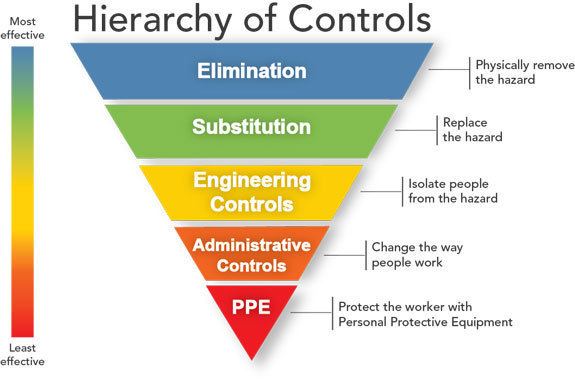 | ||
Hierarchy of hazard control is a system used in industry to minimize or eliminate exposure to hazards. It is a widely accepted system promoted by numerous safety organizations. This concept is taught to managers in industry, to be promoted as standard practice in the workplace. Various illustrations are used to depict this system, most commonly a triangle.
Contents
- Elimination
- Substitution
- Engineering controls
- Administrative controls
- Personal protective equipment
- References
The hazard controls in the hierarchy are, in order of decreasing effectiveness:
Elimination
Eliminating the hazard—physically removing it—is the most effective hazard control. For example, if employees must work high above the ground, the hazard can be eliminated by moving the piece they are working on to ground level to eliminate the need to work at heights.
Substitution
Substitution, the second most effective hazard control, involves replacing something that produces a hazard (similar to elimination) with something that does not produce a hazard—for example, replacing lead-based paint with acrylic paint. To be an effective control, the new product must not produce another hazard. Because airborne dust can be hazardous, if a product can be purchased with a larger particle size, the smaller product may effectively be substituted with the larger product.
Engineering controls
The third most effective means of controlling hazards is engineered controls. These do not eliminate hazards, but rather isolate people from hazards. Capital costs of engineered controls tend to be higher than less effective controls in the hierarchy, however they may reduce future costs. For example, a crew might build a work platform rather than purchase, replace, and maintain fall arrest equipment. "Enclosure and isolation" creates a physical barrier between personnel and hazards, such as using remotely controlled equipment. Fume hoods can remove airborne contaminants as a means of engineered control.
Administrative controls
Administrative controls are changes to the way people work. Examples of administrative controls include procedure changes, employee training, and installation of signs and warning labels (such as those in the Workplace Hazardous Materials Information System). Administrative controls do not remove hazards, but limit or prevent people's exposure to the hazards, such as completing road construction at night when fewer people are driving.
Personal protective equipment
Personal protective equipment (PPE) includes gloves, Nomex/Uniform, respirators, hard hats, safety glasses, high-visibility clothing, and safety footwear. PPE is the least effective means of controlling hazards because of the high potential for damage to render PPE ineffective. Additionally, some PPE, such as respirators, increase physiological effort to complete a task and, therefore, may require medical examinations to ensure workers can use the PPE without risking their health.
